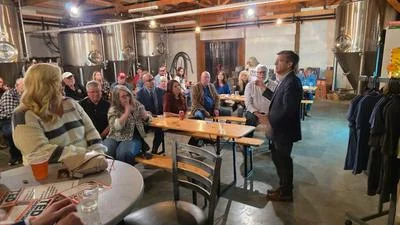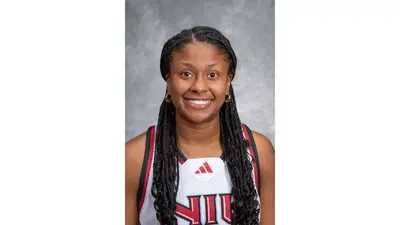University of Illinois College of Engineering issued the following announcement on Aug. 27
The Grainger College of Engineering offers multiple summer programs to engage high school students in engineering and STEM research. Finley Odar and Theodore Varona are 11th-grade students from Arlington Tech in Virginia, who participated in the Grainger Engineering Young Scholars (GEnYuS) program. Odar and Varona were mentored by their engineering teacher, Steve Nystrom, and worked in bioengineering professor Holly Golecki's lab for the summer. For their project, the team worked on a smart vest that uses biometric feedback to provide a "hug" to a dog when the vest detects the dog is anxious. When the students first met with Golecki to discuss project options, they expressed interest in combining their love of animals with robotics, specifically soft robotics. “In outreach it is critical to meet students where they are and combine their interests with a technical project. This was a perfect opportunity for them to gain skills in designing and building mechanical and electrical components with biofeedback, in an application that is important to them and their pets,” said Golecki.
Dogs can commonly experience anxiety and elevated heart rates during thunderstorms, fireworks or when they are home alone. Applying pressure around the dog, by simulating a "hug" can help reduce canine anxiety. The team designed a wearable device that actuates based on the dog's heart rate. The Thundershirt is an existing product on the market, but it provides constant pressure on the dog instead of reacting to the dog's needs based on its biometric data.
"I’m really impressed by what the team was able to accomplish remotely, from interviewing veterinarians, meetings with Siebel Center for Design, to 3D printing designs for the vest mechanisms. The students experienced an authentic design cycle and what it takes to go from concept to prototype ," said Golecki.
The team's first prototype used pneumatics to pump up a compression vest, but found that the process was too loud and could potentially add more stress to the canine.
"My key takeaways for prototyping and building wearable devices is that it will take a lot of iterations, and a lot of small changes. We went through at least 3 different versions of the same thing, just with different ways to tighten the vest, all to reach the same end goal," said Varona.
The final design includes a vest with two straps connected to a motor that can tighten around the torso. The team programmed the heart rate monitor and the motor using Arduino. They also used Python to program automatic text alerts to the dog's owner when compression occurs.
High school is an important time for students to explore future career paths and learn new skills. For many students, pre-engineering programs can encourage them to consider engineering majors in college by exposing them to new technical skills like coding and soft skills like public speaking. Even learning how to ask for help and persevering after a failure can be key takeaways for these students. Current Grainger Engineering students in Golecki's lab, Adia Radecka and Alyssa Bradshaw, served as student mentors for Varona and Odar.
Golecki said, "Working with young students, the next generation of scientists and engineers is always inspiring. We hope they get a taste of what a future in STEM might look like. . I'm really excited to see what Finley and Theo decide to do next."
Before this summer, Odar had been curious about engineering and web design. "Now I have narrowed something in engineering down to mechanical engineering. I really enjoyed the building, designing, and problem-solving parts of this project and I am now more pointed in that direction in terms of what I want to study and my future career path," she said. This experience has also helped to cement Varona's interest in pursuing engineering.
"From doing basic research calling veterinarians, cycling through the engineering design process, to breaking out a sewing machine and personalizing their dog vest. I had a great time working with them and encouraging them to think deeply about their problems, postulate potential solutions, and overcome obstacles," said Nystrom.
This summer experience culminated in a poster and presentation to Dr. Deborah Jackson from the National Science Foundation (NSF) who leads the Microelectronics, Sensors, and Information Technologies Cluster within the Engineering Research Center's (ERC) Program office. This summer experience was made possible through the support of the NSF. The team also presented at the High School Summer STEM Research Symposium hosted by the Worldwide Youth in Science and Engineering Program at Grainger Engineering.
Looking forward, Odar and Varona have been invited to participate in the Biomedical Engineering Society's (BMES) High School Poster Expo Competition at the annual meeting this October. The students are required to complete a capstone project in their senior year at Arlington Tech and are looking forward to fine-tuning and iterating upon this wearable device.
Original source can be found here.
Source: University of Illinois College of Engineering






 Alerts Sign-up
Alerts Sign-up